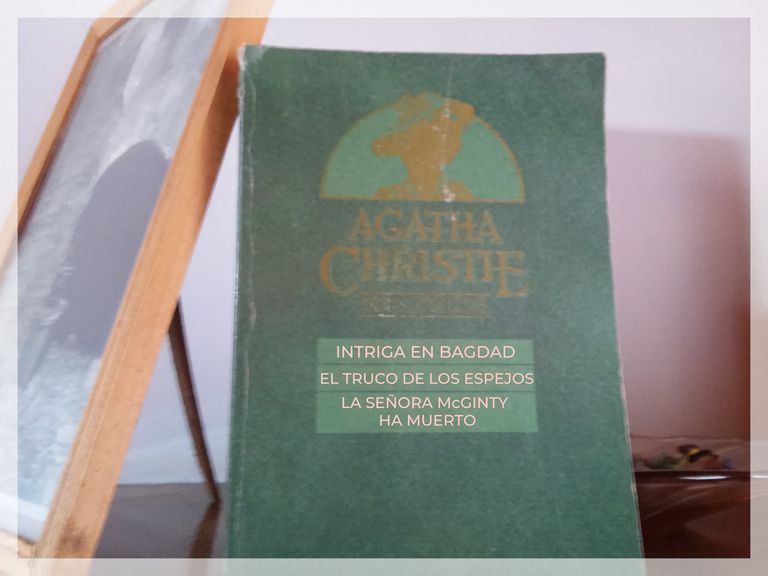
When we try to remember some true milestones in the history of detective and suspense literature, we immediately remember Agatha Christie. The celebrated British writer who delighted us so much when we were young and still continues to do so today, through many of her stories, true works of art in their genre.
To get an idea of the worldwide success achieved by her works (many will remember Ten Little Niggers, also known as And Then There Were None to avoid racist connotations), let's remember that she is the second most translated British writer in the world after William Shakespeare.
A few weeks ago, tidying up my library, I recovered a couple of books by Agatha Christie, from those volumes that publishers some years ago launched to the market, including in each volume several short stories.
This volume that I have just reread, I think for the third time in my life, includes three stories: Intrigue in Baghdad, The Mirror Trick and Mrs. Ginty is Dead.
And as you can see it is quite deteriorated. Perhaps the green color of the cover has been mixed with the titles and is very little visible, for that reason I have been forced to reprint them.
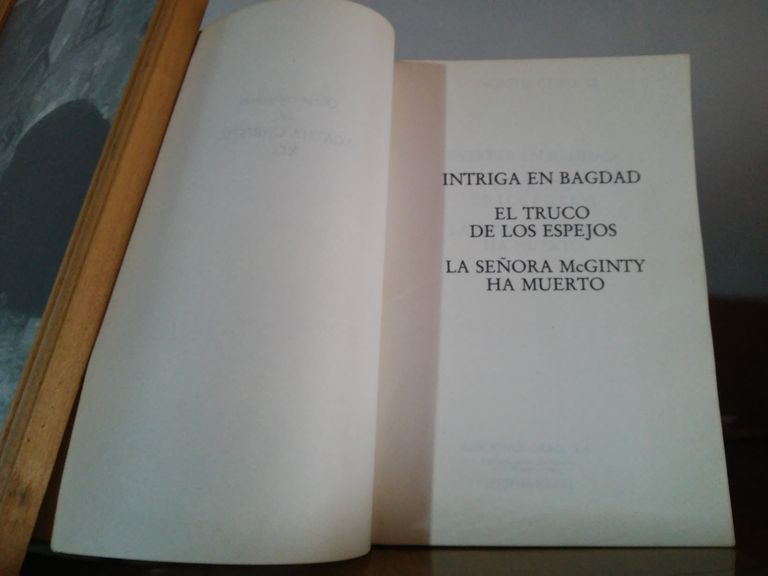
Cuando tratamos de recordar algunos verdaderos hitos en la historia de la literatura policial y de suspenso, nos acordamos inmediatamente de Agatha Christie. La celebrada escritora británica que tanto nos deleitara siendo jóvenes y aun hoy continúa haciéndolo, a través de muchos de sus cuentos, verdaderas obras de arte en su género.
Para tener una idea del suceso alcanzado a nivel mundial por sus obras (muchos recordarán Diez Negritos, también conocida como Y No Quedó Ninguno para evitar connotaciones racistas) recordemos que es la segunda escritora británica más traducida en el mundo después de William Shakespeare.
Hace unas semanas poniendo orden en mi biblioteca recuperé un par de libros de Agatha Christie, de esos volúmenes que las editoriales de hace algunos años lanzaban al mercado, incluyendo en cada tomo varios cuentos.
Este tomo que acabo de releer, creo que por tercera vez en mi vida, incluye tres cuentos: Intriga en Bagdad, El Truco de los Espejos y la Señora Ginty ha Muerto.
Y como pueden ver está bastante deteriorado. Tal vez el color verde de la portada se ha ido mezclando con los títulos y se ve muy poco, por ese motivo me he visto obligado a reeditarlos.

Intrigue in Baghdad./ Intriga en Bagdad.
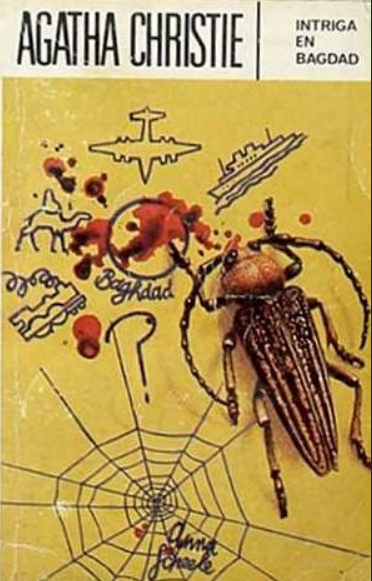
Although the entire plot is a work of fantasy, the idea of writing the book was suggested to Agatha Christie herself by the trip she made to Baghdad in 1950 with her second husband, archaeologist Max Mallowan.
The characters include Victoria Jones, a young English stenographer who has just lost her job. Suddenly she meets Edward, a young man who was going to Baghdad to work with Dr. Rathbone, an intellectual cultural preservationist.
Victoria falls in love with young Edward, who has to go to Baghdad and manages to follow him as a companion to an old lady, pretending to be the niece of an archaeologist (we see how the fantasy aspects of the play and other aspects of real life begin to intermingle here). In Baghdad the romantic plot is complicated by dangerous espionage adventures.
Captain Crosbie, a British agent in the Middle East, meets with a diplomatic corps official named Dakin, who pretends in real life to be a quiet oil company executive. In reality, their mission is to coordinate security measures at the International Conference on Security in the Middle East, where the two major powers will present their views: USA and URSS.
It is a moment of tension for the whole world because the chances of reaching an agreement are, a priori, minimal.
However, there is an agent named Henry Carmichael, son of a British army officer, born in Kasghar -Iraq- with a deep knowledge of the Middle East, who speaks several languages, among them Persian, Hindustani, Shift, Armenian and several dialects.
Making use of his extensive network of contacts he has uncovered an international conspiracy that could unite the forces of both giants to make a common front.
Carmichael must reach Baghdad before the summit meeting begins, dodging hitmen who try to assassinate him at every turn. Wounded and with his last remaining strength, he arrives at the hotel room where Victoria is staying, utters three words and dies.
Alone (or almost alone) in an unknown world, the young woman, horrified, soon finds herself involved in a world where cunning would be the most effective weapon to fight against the forces that use any method to prevent the truth from being known.
Finally, and after a series of vicissitudes, Carmichael's message arrives in Dakin's hands. Before presidents and heads of state during the opening of the conference, he explains (with the evidence to prove it) the existence of secret laboratories and installations in the middle of the desert with the aim of dividing humanity into two irreconcilable camps.
Before a stupefied assembly, he shows the microfilms that Carmichael has sent him.

Si bien toda la trama es una obra de fantasía, la idea de escribir el libro se la sugirió a la misma Agatha Christie, el viaje que hizo a Bagdad en 1950 con su segundo marido, el arqueólogo Max Mallowan.
Entre los personajes se destacan Victoria Jones, una joven taquígrafa inglesa que acaba de perder su trabajo. De pronto conoce a Edward, un joven que se iba a ir a Bagdad a trabajar con el doctor Rathbone, un intelectual preservador de la cultura.
Victoria se enamora del joven Edward, que ha de marchar a Bagdad y se las ingenia para seguirle como señorita de compañía de una anciana, fingiéndose sobrina de un arqueólogo (vemos como ya aquí comienzan a entremezclarse aspectos de fantasía propios de la obra y otros de la vida real). En Bagdad la trama romántica se complica con aventuras peligrosas de espionaje.
El capitán Crosbie agente inglés en el Medio Oriente, se reúne con un funcionario del cuerpo diplomático llamado Dakin, quien se hace pasar en la vida real por un tranquilo ejecutivo de una compañía petrolera. En realidad, la misión de ambos es coordinar las medidas de seguridad en la Conferencia Internacional sobre la seguridad en Medio Oriente, donde expondrán sus puntos de vista las dos principales potencias: EE. UU y la U.R.S.S.
Es un momento de tensión para el mundo entero porque las posibilidades de llegar a un acuerdo, son, a priori, mínimas.
Sin embargo hay un agente llamado Henry Carmichael, hijo de un oficial del ejército británico, nacido en Kasghar -Irak- profundo conocedor del Medio Oriente, que habla varios idiomas, entre ellos el persa, el indostano, el turno, el armenio y varios dialectos.
Haciendo uso de su extensa red de contactos que ha descubierto una conjura internacional que podría unir las fuerzas de ambos gigantes para hacer un frente común.
Carmichael debe llegar a Bagdad antes que inicie la reunión cumbre, sorteando sicarios que tratan de asesinarlo a cada paso. Herido y con las últimas fuerzas que le quedan llega hasta la habitacion del hotel en el que aloja Victoria, pronuncia tres palabras y muere.
Sola (o casi) en un mundo desconocido, la joven, horrorizada, pronto se ve involucrada a su mal grado en un mundo donde la astucia sería el arma más eficaz para combatir contra las fuerzas que utilizan cualquier método para evitar que la verdad sea conocida.
Finalmente, y luego de sortear innumerables peripecias, el mensaje de Carmichael llega a manos de Dakin. Ante presidentes y jefes de estado durante la apertura de la conferencia explica (con las pruebas que lo atestiguan) la existencia de laboratorios e instalaciones secretas en medio del desierto con el objeto de dividir la humanidad en dos bandos irreconciliables.
Ante una asamblea estupefacta, muestra los microfilms que Carmichael le ha hecho llegar.
| Character / Personaje | Rol / Role |
|---|---|
| Victoria Jones | Young stenographer / Joven taquígrafa |
| Henry Carmichael | Courageous British agent / Valeroso agente británico |
| Richard Baker | Young archaeologist / Joven arqueólogo |
| Dakin | Head of the British secret service in the Middle East / Jefe del servicio secreto británico en Medio Oriente |
| Pauncefoot Jones | Famous archaeologist / Arqueólogo famoso |

They Do It with Mirrors. / El Truco de los Espejos.
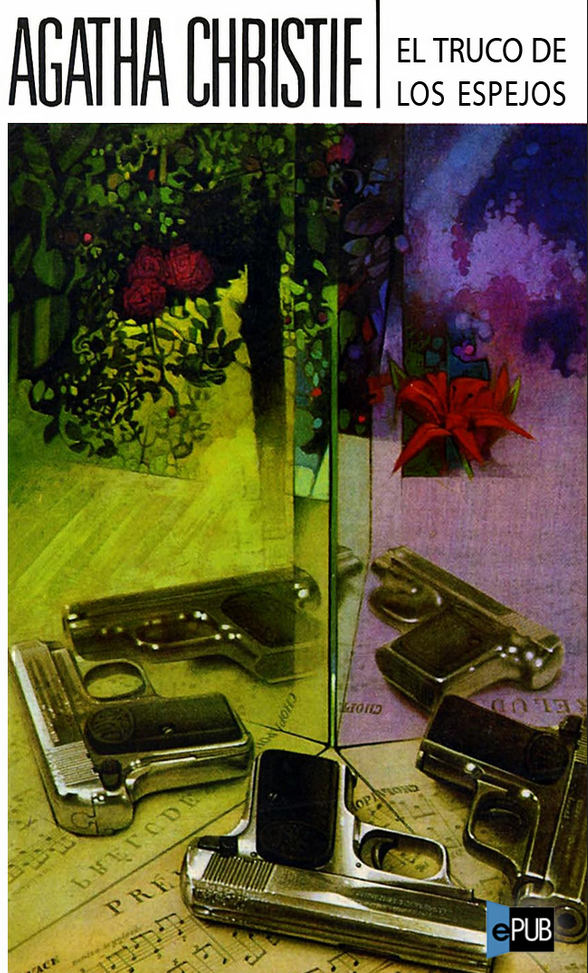
This novel has also been published in English as Murder with Mirrors.
Miss Marple and Hercule Poirot are famous characters created by the pen (or typewriter) of Agatha Christie.
Just as Sir Arthur Conan Doyle immortalized his Sherlock Holmes to the whole world, so did Agatha, but by adding a female detective to the male one. Today we would say "gender parity", at the time this word was not even remotely known. However, the British writer knew how to capture the public of both sexes by adding to the famous Poirot a sort of female alter ego: Miss Murple, who intervenes in this story.
The popular old lady with white hair, who loves birdwatching with her binoculars, her garden and her passion for knitting that helps her to meditate, has learned to evaluate human psychology in her hometown.
Indeed, as she herself declares, in St. Mary Mead, the town where she lives, absolutely nothing happens. It is alarmingly monotonous, but this has helped her to observe carefully each of its inhabitants and to analyze the causes that lead them to commit certain actions (good and bad) without apparent explanation. This has led her to develop a "special sense of smell to discover human evil" added to the fact that because she is a frail old woman, she goes totally unnoticed by most criminals.
In this story Miss Murple meets an American friend, Mrs. Van Rydock, who shows her some concern for the fate of her sister Carrie Louise who lives in Stonygates. Especially since the old Victorian house they live in has become a haven for young delinquents.
Miss Murple goes to visit Carrie Louise and her family and discovers a host of characters living in the house, seemingly with no emotional connection between them. And yet they all seem to connect through Carrie Louise, who is also inhabited by Mildred Strete, daughter of the first marriage, who in turn has an adopted daughter who dies at the birth of her daughter Gina, who has already married Walter Hudd, of American nationality.
As usual in Agatha Christie's novels, new characters are gradually added to the plot, making it increasingly difficult to predict the possible culprit.
Between children and stepchildren, friends, depressed assistants suffering from persecution mania and those who claim to be illegitimate children of important men, a dense atmosphere of intrigues and distrust develops where each character ends up distrusting the other. Even Carrie Louise's stepson, Christian Gulbrandsen, is a member of the Stonygates board of directors and comes as a surprise to spend the weekend.
As in most mystery novels of that era, the current jumps at a certain point to increase the tension. At that moment, Miss Murple and the rest are in the parlor while Guldbransen retires to the guest room to write a letter.
When the lights come back on in a fit of hysteria (or not) one of the young men named Edwar Lawson accuses Serrocold of being his father, locks himself and Guldbransen in the study to argue, and suddenly gunshots are heard. When they open the door they discover that the young man has only shot against the wall to scare his interlocutor.
After this moment of anguish, everyone discovers that one member is missing: Christian Guldbransen, the member of the board of directors who had locked himself in his room to write a letter and about whom no one knew the reasons for his unexpected visit. He has been shot in the back while sitting at his typewriter. The letter has disappeared and Miss Murple begins to investigate and draw deductions, true to her style.
The clues lead her to think that Serrocold is the culprit. And, indeed, he confesses to the police to have stolen the letter so as not to tip off the real murderer.
Both he and Guldbransen suspected that the causes of Carrie Louise's deteriorating health were due to a presumed poisoning.
Miss Murple supposes that like the trick of the mirrors that magicians and illusionists regularly follow, nothing is as it seems. And she confirms it when Alex Restarick, Carrie Louise's stepson, comes into action.
Thanks to her special way of reasoning, Miss Murple calmly and methodically uncovers new details until she discovers the true identity of the murderer who dies while trying to save himself and his accomplice.
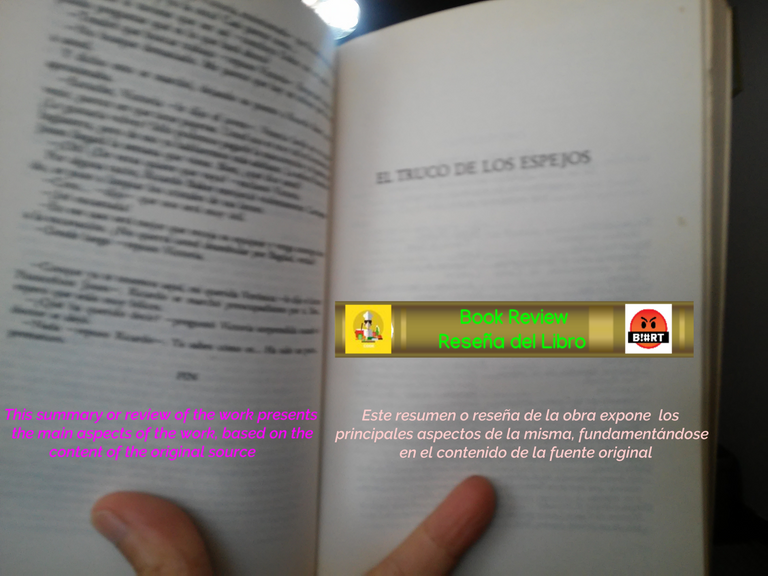
Esta novela también ha sido publicada en inglés con el nombre de Murder with Mirrors.
Miss Marple y Hércules Poirot son personajes célebres creamos por la pluma (o la máquina de escribir) de Agatha Christie.
Así como Sir Arthur Conan Doyle inmortalizó su Sherlock Holmes al mundo entero, Agatha también lo hizo, pero agregándole un detective femenino al masculino. Hoy diríamos "paridad de género", en ese momento esta palabra no era ni siquiera remotamente conocida. Sin embargo la escritora británica supo captar al público de ambos sexos agregando al famoso Poirot una especie de alter ego femenino: Miss Murple, que interviene en este cuento.
La popular anciana con el pelo blanco, amante del birdwatching con sus prismáticos, de su jardín y de su pasion por el tejido que la ayuda a meditar, ha aprendido a evaluar la psicología humana en su pueblo natal.
En efecto, como ella mismo lo declara, en St. Mary Mead el pueblo donde vive no pasa absolutamente nada. Es de una monotonía alarmante, pero eso le ha servido para observar detenidamente a cada uno de sus habitantes y analizar las causas que los llevan a cometer ciertas acciones (buenas y malas) sin aparente explicación. Esto le ha llevado a desarrollar un "especial olfato para descubrir la maldad humana" agregado al hecho que por sus condiciones de anciana frágil pasa totalmente desapercibida para la mayoría de los criminales.
En este cuento Miss Murple encuentra una amiga estadounidense, la señora Van Rydock, la cual le muestra una cierta preocupación por la suerte de su hermana Carrie Louise que vive en Stonygates. Sobre todo porque la vieja casa victoriana en la que viven se ha convertido en un refugio de jóvenes delincuentes.
Miss Murple va a visitar a Carrie Louise y su familia y descubre una gran cantidad de personajes que viven en la casa, aparentemente sin ningún nexo afectivo entre ellos. Y sin embargo todos parecen conectarse a través de Carrie Louise con quien habita también Mildred Strete hija del primer matrimonio que a su vez tiene una hija adoptada que muere al nacer su hija Gina, la cual ya grande ha contraído matrimonio con Walter Hudd, de nacionalidad estadounidense.
Como es normal en las novelas de Agatha Christie, de a poco se van agregando nuevos personajes a la trama, haciéndolo cada vez más difícil el vaticinio sobre el posible culpable.
Entre hijos e hijastros, amigos, asistentes depresivos que sufren de la manía de persecución y quienes afirman ser hijos ilegítimos de hombres importantes, se va desarrollando un clima denso de intrigas y desconfianzas donde cada personaje termina desconfiando del otro. Incluso el hijastro de Carrie Louise, Christian Gulbrandsen, es miembro del consejo den administración de Stonygates y llega a sorpresa para pasar el fin de semana.
Como en la mayor parte de las novelas de misterio de esa epoca, salta la corriente en un determinado momento para aumentar la tensión. En ese momento, Miss Murple y el resto se encuentran en el salón mientras Guldbransen se retira en la habitacion de los huéspedes para escribir una carta.
Al volver la luz en un ataque de histeria (o no) uno de los jóvenes llamado Edwar Lawson acusa a Serrocold de ser su padre, se encierra con él a discutir en el estudio y de repente se sienten disparos. Cuando abren la puerta descubren que el joven ha solo disparado contra la pared para asustar a su interlocutor.
Pasado este momento de angustia, todos descubren que falta un integrante: Christian Guldbransen, el integrante del consejo de administración que se había encerrado en su cuarto a escribir una carta y sobre el cual ninguna conocía los motivos de su inesperada visita. Le han disparado en la espalda mientras estaba sentado junto a su máquina de escribir. La carta ha desaparecido y Miss Murple comienza a investigar y a sacar deducciones, fiel a su estilo.
Los indicios llevan a pensar en Serrocold como culpable. Y, en efecto, este confiesa a la policia de haber sustraído la carta para no poner sobre aviso al verdadero asesino.
Tanto el cómo Guldbransen sospechaban que las causas del deterioro en la salud de Carrie Louise se debían a un presunto envenenamiento.
Miss Murple supone que como el truco de los espejos que siguen regularmente magos e ilusionistas, nada es como parece. Y lo confirma cuando Alex Restarick, el hijastro de Carrie Louise entra en acción.
Gracias a su especial modo de razonar Miss Murple, con calma metódica va descubriendo nuevos detalles hasta descubrir la verdadera identidad del asesino que muere al intentar salvarse él y su cómplice.
| Character / Personaje | Rol / Role |
|---|---|
| Miss Marple | Amateur sleuth / Detective amateur |
| Carrie Louise | childhood friend of Miss Marple / amiga de la infancia de Miss Marple |
| Lewis Serrocold | Husband of Carrie Louise / marido de Carrie Louise |
| Alex Restarick | Stepson of Carrie Louise / hijastro de Carrie Louis |
| Stephen Restarick | Stepson of Carrie Louise / hijastro de Carrie Louis |

Mrs. McGinty's Dead. / La Señora McGinty Ha Muerto.

In the review of the previous novel we had introduced one of the two detectives created by the so-called "Queen of Crime". The other is the famous Belgian (and not French, as some think) detective Hercule Poirot and he is the main investigator in this new Agatha Christie tale.
Called by the police superintendent Spencer, Hercule Poirot must investigate a crime in which apparently everything is solved, to the point that the alleged culprit has already been convicted. However, there are some obscure points in the investigation that do not convince the superintendent who does not want to have a weight on his shoulders condemning an alleged culprit... who may be innocent.
Using his traditional and methodical system of analysis, visiting the village where the murder has been committed and interrogating all the people involved, Poirot will discover that the murderer is not James Bentley, the person who is in prison and has been sentenced to capital punishment.
Mrs. McGinty has been killed with a blow to the head. However, the instrument that caused the death has not been found.
One of the details that do not pass unnoticed by Poirot is that Mrs. McGinty had bought, shortly before she was murdered, a bottle of ink of the type used for writing a letter. Strange because it was a habit that the victim did not have.
Another apparently unconnected piece of information, but which attracts the attention of the popular investigator, is that a pair of Mrs. McGinty's shoes are wrapped in a page of the newspaper that had been published the week she was murdered. And that he still does not know if by oversight or exprofeso published an article that referred to the lives of four people who had been involved in the past in famous murders.
In order to be close to the place where the events took place, Poirot decides to stay in a boarding house in the small town where Poirot will take the opportunity to enjoy the gastronomic specialties of the place, another of his favorite pastimes, in addition to investigating.
Time is short, the condemned has appealed the death sentence and Poirot must discover who is the real murderer of Mrs. McGinty, who worked as a maid in the homes of several people in the city.
Just as in some modern films some famous writers take the opportunity to make a "cameo" of brief duration, Agatha Christie also introduces a kind of alter ego in the novel. We find her in the figure of Ariadne Oliver, a writer of detective novels who is the guest of one of Mrs. McGinty's former employers.
Poirot discovers, or rather, supposes that Mrs. McGinty could have seen and identified in one of the photos published in the newspaper a person who lived in the village. And that could have induced the real murderer to eliminate her.
The person in question is Lily Gamboll, who had committed a murder in her youth and/or of Eva Kane which apparently had been the cause of a crime of passion in which a man had murdered his wife and buried her in the cellar.
As is often the case with the detective, he often boasts of knowing more than he has actually discovered, trying to make the culprit commit a faux pas. However, this tactic proves to be too dangerous, as someone behind his back pushes him on the railroad platform and almost makes him fall under the train.
He decides to change tactics and starts showing the photos to everyone he meets.
Ariadne Oliver (Agatha Christie's alter ego) arrives in town to write the script for a play with Robin Upward. When they return from the theater where the tests are made, they find Mrs. Upward - one of the presumed connoisseurs about the identity of the murderer - strangled. She has had coffee with the killer, as lipstick marks are found. From the investigation it emerges that three people had been invited to the victim's house for coffee: Eve Carpenter, Deirdre Henderson and Shelagh Rendell. All of them deny it, except the second one who admits to have gone there but to have returned immediately when she found no one. She denies having seen the body.
Intuition tells Poirot that the motive for the murder could be hatred and he begins to concentrate on it. He shows the photos to Long Meadows and finds the solution to the crime.
And as in every case, the solution is more complex than it seems.
Robin Upward who actually occupies an excellent social position, is the son of Eva Kane (the initial confusion was because everyone thought that Evelyn was a female name and instead it was not). When Mrs. McGinty discovers the photographs, she realizes that the only way to avoid divulging the secret and the scandal is to eliminate her.
Mrs. Upward, when Poirot shows her the photographs, purposely points to any one of them, not the real one, to divert the investigations and blackmail Robin. Robin discovers this, sets up the alibi with the invitation to drink the coffee and murders Mrs. Upward.
Other secrets come to light at the end of the novel: Eve Carpenter wants to erase at all costs a sordid past and Dr. Rendell and his second wife believe that Poirot has come to town to investigate the crime of which he is the author (of his first wife) and tries to throw him under the train.
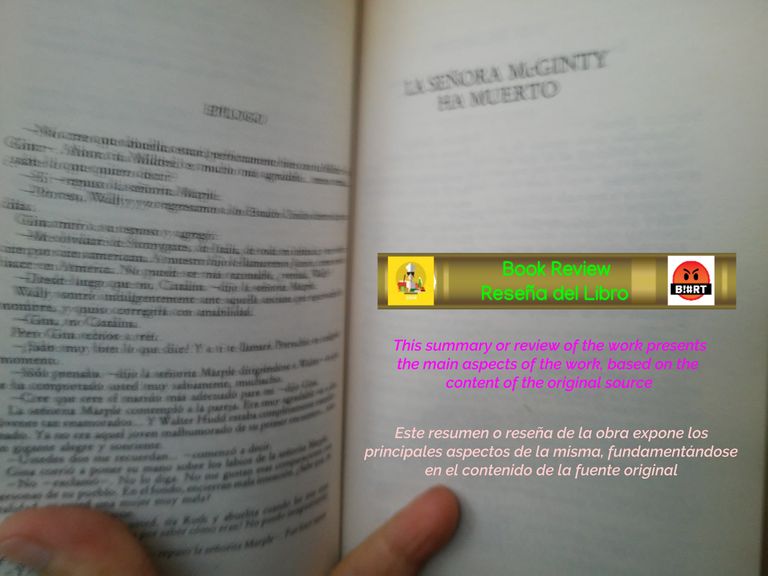
En la reseña de la novela anterior habíamos introducido uno de los dos detectives creados por la llamada "Reina del Crimen". El otro es el famoso detective belga (y no francés, como piensan algunos) Hércules Poirot y es el investigador principal en este nuevo cuento de Agatha Christie.
Llamado por el superintendente de policia Spencer, Hercules Poirot debe investigar sobre un delito en el que aparentemente todo está resuelto, a punto tal que el presunto culpable ya ha sido condenado. Sin embargo hay algunos puntos oscuros en la investigación que no terminan de convencer al superintendente quien no quiere tener un peso sobre sus espaldas condenando a un presunto culpable... que puede ser inocente.
Usando su tradicional y metódico sistema de análisis, visitando el pueblo donde se ha cometido el asesinato e interrogando a todas las personas involucradas, Poirot descubrirá que el asesino no es James Bentley, la persona que está en la cárcel y ha sido condenado a la pena capital.
La señora McGinty ha sido asesinada con un golpe en la cabeza. Sin embargo el instrumento que ha provocado la muerte no ha sido encontrado.
Uno de los detalles que no pasan inobservados a Poirot es que la señora McGinty había comprado, poco antes de ser asesinada, un frasco de tinta del tipo que se utiliza para escribir una carta. Extraño porque era una costumbre que la víctima no tenía.
Otro dato aparentemente sin conexión, pero que llama la atención del popular investigador, es que un par de zapatos de la señora McGinty están envueltos en una página del diario que había salido la semana en que había sido asesinada. Y que todavía no sabe si por descuido o exprofeso publicaba un artículo que se refería a la vida de cuatro personas que habian sido involucradas en el pasado en famosos homicidios.
Para estar cerca del lugar donde se han desarrollado los acontecimientos, Poirot decide hospedarse en una pensión de la pequeña ciudad donde aprovechara Poirot para disfrutar de las especialidades gastronómicas del lugar, otro de sus pasatiempos preferidos, además del de investigar.
El tiempo apremia, el condenado ha apelado la sentencia de muerte y Poirot debe descubrir quien es el verdadero asesino de la señora McGinty, que trabajaba como empleada doméstica en las casas de varias personas de la ciudad.
Así como en algunas películas modernas algunos escritores famosos aprovechan para hacer un "cameo" de breve duración, también Agatha Christie introduce una especie de alter ego en la novela. La encontramos en la figura de Ariadne Oliver, escritora de novelas policíacas que es huésped de una de las ex patronas de la Sra. McGinty.
Poirot descubre, o mejor dicho, supone que la señora McGinty podría haber visto e identificado en una de las fotos publicadas en el diario a una persona que habitaba en el pueblo. Y eso podría haber inducido al verdadero asesino a eliminarla.
La persona en cuestión es Lily Gamboll, que había cometido un asesinato en su juventud y/o de Eva Kane que aparentemente había sido la causa de un crimen pasional en el cual un hombre había asesinato su mujer y la había sepultado en el sótano.
Como es frecuente en el detective, muchas veces se vanagloria de saber más de lo que realmente ha descubierto, tratando de hacer que el culpable cometa un paso en falso. Sin embargo esta táctica se revela demasiado peligrosa, ya que alguien a sus espaldas lo empuja en el andén del ferrocarril y casi lo hace caer bajo el tren.
Decide de cambiar táctica y comienza a mostrar las fotos a todas las personas que encuentra.
Ariadne Oliver (el alter ego de Agatha Christie) llega al pueblo para escribir el guion de una obra teatral junto a Robin Upward. Cuando regresan del teatro donde se hacen las pruebas, encuentran a la señora Upward -una de las presuntas conocedoras acerca de la identidad del asesino- estrangulada. Ha tomado el café con la asesina, ya que se encuentran las marcas del lápiz labial. De la investigación surge que tres personas habian sido invitadas a tomar el café a casa de víctima: Eve Carpenter, Deirdre Henderson e Shelagh Rendell. Todas niegan, salvo la segunda que admite haber ido pero haberse vuelto enseguida al no encontrar a nadie. Niega haber visto el cadáver.
La intuición dice a Poirot que el motivo del asesinato podría ser el odio y comienza a concentrarse sobre ello. Muestra las fotos a Long Meadows y encuentra la solución al delito
Y como en cada caso, la solución es más compleja de lo que parece.
Robin Upward que en realidad ocupa una excelente posición social, es el hijo de Eva Kane (la confusión inicial era porque todos pensaban que Evelyn era un nombre femenino y en cambio no era así). Cuando la señoa McGinty descubre las fotografías, se da cuenta de que la única manera para evitar la divulgación del secreto y del escándalo es eliminándola.
La señora Upward cuando Poirot le muestra las fotografías, señala a propósito una cualquiera, no la verdadera, para desviar las investigaciones y poder chantajear a Robin. Este lo descubre, arma la coartada con la invitación a beber el café y asesina a la señora Upward.
Otros secretos salen a luz al final de la novela: Eve Carpenter quiere borrar a toda costa un sórdido pasado y el doctor Rendell y su segunda mujer creen que Poirot ha llegado al pueblo para investigar el crimen del cual es autor (de su primera mujer) y trata de tirarlo bajo el tren.
| Character / Personaje | Rol / Role |
|---|---|
| Hércules Poirot | Famous detective created by Agatha Christie / Famoso detective creado por Agatha Christie |
| Ariadne Oliver | Mystery writer alter ego of the author of the novel / Escritora de misterio alter ego de la autora de la novela |
| James Bentley | Detained in jail on murder charges / Detenido en la cárcel acusado de asesinato |
| Robin Upward | Son of Laura and playwrigh / hijo de Laura y dramaturgo |
| Spence | Superintendent of Kilchester Police / Superintendente de Policía de Kilchester |
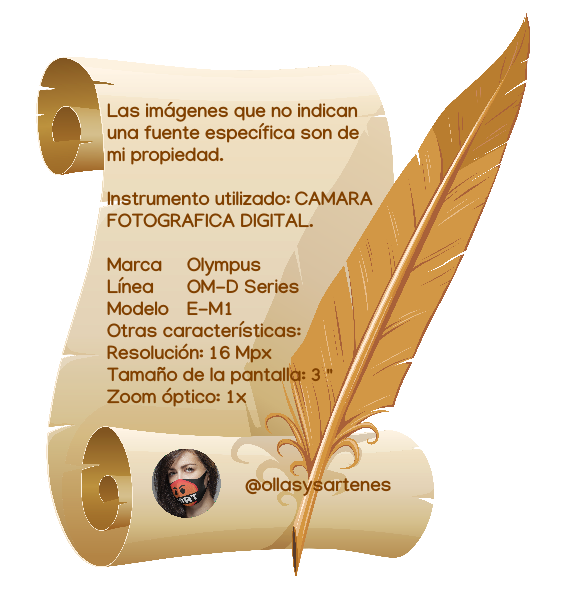

Upvoted. Thank You for sending some of your rewards to @null. Read my last posts to make sure that BLURT burning is profitable for you. Before using this bot please make sure your account has at least 100 BP. Get more BLURT:
@ mariuszkarowski/how-to-get-automatic-upvote-from-my-accounts@ blurtbooster/blurt-booster-introduction-rules-and-guidelines-1699999662965@ nalexadre/blurt-nexus-creating-an-affiliate-account-1700008765859@ kryptodenno - win BLURT POWER delegationNote: This bot will not vote on AI-generated content
Thanks @ctime!